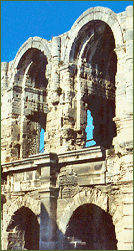|
The ?le de la Cit? was originally assumed to be the location of
the settlement, but recent archaeological finds of the largest pre Roman settlement show
this may have been in the present-day Paris suburb of Nanterre.
Paris occupied a strategic position for controlling
river shipping and commerce and lands were prosperous. The area came under Roman control
after the revolt of 52 BC when Vercingetorix led a Celtic uprising against the Romans
under Caesar.
The town sided with the rebels and it was garrisoned by Vercingetorix's lieutenant
Camulogenus, whose army camped on the Mons Lutetius, which is where the Panth?on is now
situated.
The Romans crushed the rebels at nearby Melun and then took control of the entire
region. And by the end of that century, ?le de la Cite and Left Bank Sainte
Genevieve Hill in Paris became the centre of the new Roman settlement, which they called
Lutetia.
Under Roman rule, the town grew considerably.
It was Christianised in the 3rd century when St Denis became
the city's first bishop, although the process was not entirely peaceful.
Lutetia was renamed Paris in 212, after the local tribe, but the rest of the 3rd and 4th
century was wracked by war and civil unrest.
In around 250 St Denis and two companions were arrested and decapitated on the hill of
Mons Mercurius, known after that as Mons Martis or Martyrs' Hill, but is now known as
Montmartre.
The city came under attack from barbarian invaders, prompting the construction of a
defensive city wall.
In 357 Julian, the nephew of Emperor Constantine, went to Paris and became the city's new
governor. And although his uncle was the emperor who declared Christianity the
official religion of the Empire, Julian "the Apostate" strove to roll back its
advance. Julian became the new emperor in 361 but died only two years later in
battle.
Roman rule in northern Gaul effectively collapsed in the 5th century. And this
region was invaded by Attila the Hun in 451, which then prompted fears that Paris would be
attacked.
But according to legend, the city of Paris was saved by Sainte Genevieve and her
followers, which was when their prayers for relief were answered, as Attila's army turned
away from Paris and went to the south.
This is why Sainte Genevieve remains the patron saint of Paris to this day.
But unfortunately, the city's escape from Attila proved very short lived, as it was
attacked and overrun in 464 by Childeric I, also known as Childeric the Frank.
His son Clovis I made Paris his capital in 506, yet within just a few years, was buried
there alongside Saint Genevieve upon his death in 511.
|
|



